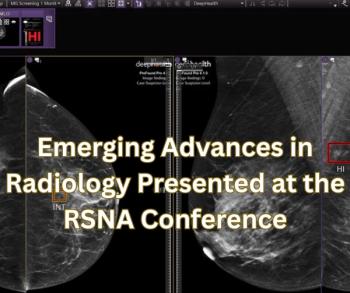
Whole-body MR with diffusion imaging matches PET/CT for lung cancer staging
A little diffusion imaging goes a long way toward boosting the accuracy of whole-body MRI and matching the performance of whole-body FDG-PET/CT for M-staging of non-small cell lung cancer.
A little diffusion imaging goes a long way toward boosting the accuracy of whole-body MRI and matching the performance of whole-body FDG-PET/CT for M-staging of non-small cell lung cancer.
Dr. Yoshiharu Ohno, an assistant professor of radiology at Kobe University Graduate School of Medicine in Japan, drew this conclusion from a prospective trial involving 203 consecutive patients. The subjects underwent whole-body anatomic MR, diffusion-weighted imaging, and whole-body FDG-PET/CT procedures. Two chest radiologists read the MR scans, and two experienced nuclear medicine physicians interpreted the PET/CT studies.
The probabilities for the presence of metastases on the three sets of images were calculated on a five-point scale on a per-patient basis. Final diagnosis was determined by consensus of the two readers. Results were confirmed with a one-year clinical follow-up.
The Kobe group found whole-body MRI with DWI is significantly more sensitive than anatomic MRI alone and slightly more sensitive than PET/CT for whole-body M-staging including the brain. The combined anatomic and functional measures were 70% sensitive for metastases compared with 60% for MRI alone. Both approaches were 92% specific for isolating metastatic disease. The sensitivity and specificity of PET/CT were 62.5% and 94.5%, respectively.
When looking at the brain alone, combined anatomic and diffusion-weighted MR imaging more accurately identified the presence and number of metastatic lesions than did FDG-PET/CT, Ohno said.
FDG-PET/CT was slightly more sensitive than MRI-DWI, however, for staging metastatic lung cancer elsewhere in the body. Its sensitivity rate was 70.6% compared with 67.6% for the integrated MRI-DWI technique. At 94.5%, the specificity rate of FDG-PET/CT was again only slightly better than the 92% rate of whole-body MRI combined with diffusion-weighted imaging.
"You need anatomic imaging from whole-body MRI and diffusion-weighted imaging," Ohno said in an interview.
His group's results were presented as a conventional scientific poster at the 2008 International Society for Magnetic Resonance Imaging in Medicine meeting in Toronto.
"If you combine the two methods, the diagnostic capability is almost equal to whole-body PET/CT for M-staging lung cancer. If you use DWI, detecting suspicious regions is easier and faster," he said.
For more information from the Diagnostic Imaging archives:
Newsletter
Stay at the forefront of radiology with the Diagnostic Imaging newsletter, delivering the latest news, clinical insights, and imaging advancements for today’s radiologists.




























